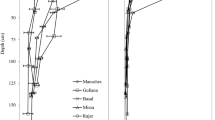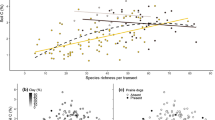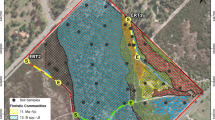Abstract
Recent interest in spatial pattern in terrestrial ecosystems has come from an awareness of the intimate relationship between spatial heterogeneity of soil resources and maintenance of plant species diversity. Soil and vegetation can vary spatially in response to several state factors of the system. In this study, we examined fine-scale spatial variability of soil nutrients and vascular plant species in contrasting herb-dominated communities (a pasture and an old field) to determine degree of spatial dependence among soil variables and plant community characteristics within these communities by sampling at 1-m intervals. Each site was divided into 25 1-m2 plots. Mineral soil was sampled (2-cm diameter, 5-cm depth) from each of four 0.25-m2 quarters and combined into a single composite sample per plot. Soil organic matter was measured as loss-on-ignition. Extractable NH4 and NO3 were determined before and after laboratory incubation (28 days at 27°C) to determine potential net N mineralization and nitrification. Cations were analyzed using inductively coupled plasma emission spectrometry. Vegetation was assessed using estimated percent cover. Most soil and plant variables exhibited sharp contrasts between pasture and old-field sites, with the old field having significantly higher net N mineralization/nitrification, pH, Ca, Mg, Al, plant cover, and species diversity, richness, and evenness. Multiple regressions revealed that all plant variables (species diversity, richness, evenness, and cover) were significantly related to soil characteristics (available nitrogen, organic matter, moisture, pH, Ca, and Mg) in the pasture; in the old field only cover was significantly related to soil characteristics (organic matter and moisture). Both sites contrasted sharply with respect to spatial pattern of soil variables, with the old field exhibiting a higher degree of spatial dependence. These results demonstrate that land-use practices can exert profound influence on spatial heterogeneity of both soil properties and vegetation in herb-dominated communities.




Similar content being viewed by others
References
Analytical Software (2008) Statistix for windows, version 9.0 ed. Analytical Software, Tallahassee, FL
Barbour MG, Burk JH, Pitts WD, Gilliam FS, Schwartz MW (1999) Terrestrial plant ecology, 3rd edn. Benjamin/Cummings, Menlo Park, CA
Beatty SW (2003) Habitat heterogeneity and maintenance of species in understory communities. In: Gilliam FS, Roberts MR (eds) The herbaceous layer in forests of eastern North America. Oxford University Press, New York, pp 177–197
Bever JD (1994) Feedback between plants and their soil communities in an old field community. Ecology 75:1965–1977
Bowman DC, Cramer GR, Devitt DA (2006) Effect of salinity and nitrogen status on nitrogen uptake by tall fescue turf. J Plant Nutr 29:1481–1490
Colwell RK, Mao CX, Chang J (2004) Interpolating, extrapolating, and comparing incidence-based species accumulation curves. Ecology 85:2717–2727
DeSteven D (1991) Experiments on mechanisms of tree establishment in old-field succession: seedling survival and growth. Ecology 72:1076–1088
Dick DA, Gilliam FS (2007) Spatial heterogeneity and dependence of soils and herbaceous plant communities in adjacent seasonal wetland and pasture sites. Wetlands 27:951–963
Dufour A, Gadallah F, Wagner HH, Guisan A, Buttler A (2006) Plant species richness and environmental heterogeneity in a mountain landscape: effects of variability and spatial configuration. Ecography 29:573–584
Dutilleul P (1993) Spatial heterogeneity and the design of ecological field experiments. Ecology 74:1646–1658
Eskelinen A, Stark S, Männistö M (2009) Links between plant community composition, soil organic matter quality and microbial communities in contrasting tundra habitats. Oecologia 161:113–123
Evans DK, Weir Z, Carson C, Good C (2004) Vascular flora and plant communities—cover types at Mill Creek, Wayne County West Virginia. Report for West Virginia Department of Transportation, Charleston, West Virginia
Fraterrigo JM, Rusak JA (2008) Disturbance-driven changes in the variability of ecological patterns and processes. Ecol Lett 11:756–770
Gilliam FS (2006) Response of the herbaceous layer of forest ecosystems to excess nitrogen deposition. J Ecol 94:1176–1191
Gilliam FS, Turrill NL (1993) Herbaceous layer cover and biomass in young versus mature stands of a Central Appalachian hardwood forest. Bull Torrey Bot Club 120:445–450
Gilliam FS, Lyttle NL, Thomas A, Adams MB (2005) Soil variability along a nitrogen mineralization/nitrification gradient in a nitrogen-saturated hardwood forest. Soil Sc Soc Am J 69:247–256
Gotelli N, Colwell RK (2001) Quantifying biodiversity: procedures and pitfalls in the measurement and comparison of species richness. Ecol Lett 4:379–391
Housman MJ, Yeager CM, Darby BJ, Sanford RL Jr, Kuske CR, Neher DA, Belnap J (2007) Heterogeneity of soil nutrients and subsurface biota in a dryland ecosystem. Soil Biol Biochem 39:2138–2149
Hutchings MJ, John E, Wijesinghe DK (2003) Toward understanding the consequences of soil heterogeneity for plant populations and communities. Ecology 84:2322–2334
Iqbal J, Thomasson JA, Jenkins JN, Owens PR, Whisler FD (2005) Spatial variability analysis of soil physical properties of alluvial soils. Soil Sci Soc Am J 69:1338–1350
Jackson RB, Caldwell MM (1993) Geostatistical patterns of soil heterogeneity around individual perennial plants. J Ecol 81:683–692
Jenny H, Arkley RJ, Schultz AM (1969) The pygmy forest-podsol ecosystem and its dune associates of the Mendocino coast. Madroño 20:60–74
Kreft H, Jetz W (2007) Global patterns and determinants of vascular plant diversity. Proc Natl Acad Sci 104:5925–5930
Lovett GM, Jones CG, Turner MG, Weathers KC (eds) (2005) Ecosystem function in heterogeneous landscapes. Springer, New York
Lundholm JT, Larson DW (2003) Relationships between spatial environmental heterogeneity and plant species diversity on a limestone pavement. Ecography 26:715–722
May JD, Burdette E, Gilliam FS, Adams MB (2005) Interspecific divergence in foliar nutrient dynamics and stem growth in a temperate forest in response to chronic nitrogen inputs. Can J For Res 35:1023–1030
McClain ME, Boyer EW, Dent CL, Gergel SE, Grimm NB, Groffman PM, Hart SC, Harvey JW, Johnston CA, Mayorga E, McDowell WH, Pinay G (2003) Biogeochemical hot spots and hot moments at the interface of terrestrial and aquatic ecosystems. Ecosystems 6:301–312
Minasny B, McBratney AB, Whelan BM (2005) VESPER version 1.62. Australian Centre for Precision Agriculture, McMillan Building A05, The University of Sydney, New South Wales 2006. http://www.usyd.edu.au/su/agric/acpa
Palmer MW (1990) Spatial scale and patterns of species-environment relationships in hardwood forest of the North Carolina piedmont. Coenoses 5:79–87
Paré K, Chantigny MH, Carey K, Johnston WJ, Dionne J (2006) Nitrogen uptake and leaching under annual bluegrass ecotypes and bentgrass species: a lysimeter experiment. Crop Sci 46:847–853
Parkin TB (1993) Spatial variability of microbial processes in soil: a review. J Environ Qual 22:409–417
Raynal DJ, Bazzaz FA (1975) Interference of winter annuals with Ambrosia artemisiifolia in early successional fields. Ecology 56:35–49
Ricklefs RE (1977) Environmental heterogeneity and plant species diversity. Am Nat 111:376–381
Robertson GP (1987) Geostatistics in ecology: interpolating with known variance. Ecology 68:744–748
Robertson GP, Hutson MA, Evans FC, Tiedje JM (1988) Spatial variability in a successional plant community: patterns of nitrogen availability. Ecology 69:1517–1524
Schenk HJ, Jackson RB (2002) The global biogeography of roots. Ecol Monogr 72:311–328
Schlesinger WH, Raikes JA, Hartley AE, Cross AF (1996) On the spatial pattern of soil nutrients in desert ecosystems. Ecology 77:364–374
Slagle A, Skousen J, Bhumbla D, Sencindiver J, McDonald L (2004) Trace element concentrations of three soils in central Appalachia. Soil Surv Horiz 45:73–85
Small CJ, McCarthy BC (2002) Spatial and temporal variability of herbaceous vegetation in an eastern deciduous forest. Plant Ecol 164:37–48
Smith AE (ed) (1995) Handbook of weed management systems. Marcel Dekker, New York
Strasbaugh PD, Core EL (1977) Flora of West Virginia, 2nd edn. Seneca Books, Inc., Morgantown, WV
Thompson TL, Zaady E, Huancheng P, Wilson TB, Martens DA (2006) Soil C and N pools in patchy shrublands of the Negev and Chihuahuan Deserts. Soil Biol Biochem 38:1943–1955
USDA, NRCS (2004) The PLANTS database, version 3.5 (http://plants.usda.gov). National Plant Data Center, Baton Rouge, LA 70874-4490, USA
van der Krift TAJ, Berendse F (2001) The effect of plant species on soil nitrogen mineralization. J Ecol 89:555–561
Wedin D, Tilman D (1990) Species effects on nitrogen cycling: a test with perennial grasses. Oecologia 84:433–441
Wilsey BJ, Potvin C (2000) Biodiversity and ecosystem functioning: importance of species evenness in an old field. Ecology 81:887–892
Xi W, Peet RK, Urban DL (2008) Changes in forest structure, species diversity and spatial pattern following hurricane disturbance in a Piedmont North Carolina forest. USA J Plant Ecol 1:43–57
Zar JH (2009) Biostatistical analysis, 5th edn. Prentice Hall, Upper Saddle River, NJ
Acknowledgments
This study was funded by Project ATI TRP 99-09 by the Nick J. Rahall II Appalachian Transportation Institute. We are grateful to Donnie Kinnan for his assistance in the field and laboratory. We are indebted to the plant taxonomic expertise of Dan Evans, Curator, Marshall University Herbarium (MUHW), for assistance in identifying plant specimens.
Author information
Authors and Affiliations
Corresponding author
Rights and permissions
About this article
Cite this article
Gilliam, F.S., Dick, D.A. Spatial heterogeneity of soil nutrients and plant species in herb-dominated communities of contrasting land use. Plant Ecol 209, 83–94 (2010). https://doi.org/10.1007/s11258-010-9725-x
Received:
Accepted:
Published:
Issue Date:
DOI: https://doi.org/10.1007/s11258-010-9725-x




